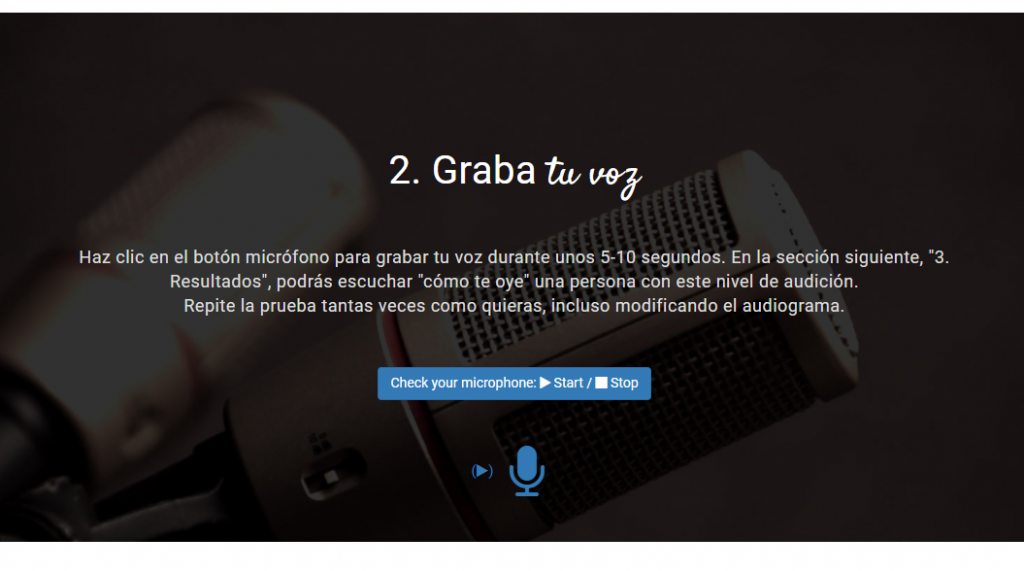At ComoMeOyes we have developed an application to simulate how a person with hearing loss hears your voice.
Click on the image above to go to the ComoMeOyes application and experience this hearing simulation as a deaf person. If you have the audiogram of a person you know with hearing loss, we recommend that you customize the audiogram that you will find, to “put yourself in their ears” for a few moments and hear like him or her.
How does the ComoMeOyes application work?
After recording your voice for a maximum of 10 seconds, the ComoMeOyes application creates 4 videos.
- The first one is simply your voice, as you hear it.
- The second is the simulation of how the deaf person (with the hearing loss represented by the audiogram) hears your voice, just as you have chosen or customized it (mild, moderate, profound loss, or with the audiogram that you have personalized with the audiometry of your known person).
- The other two videos correspond to isolating only the hearing loss from each of the two ears.

What is the ComoMeOyes application for?
The goal of ComoMeOyes application is to listen to our own voice, with the ears of a person with hearing impairment. Living in our ears how a deaf person hears our own voice allows us to “put ourselves in their shoes”, or rather, “put ourselves in their ears”. It is an experience of empathy.
“What is empathy for?” Some may ask, perhaps with some bitterness. Well, apart from the obvious explanations, I would ask the most reticent people: why do human beings have the need to communicate? Putting ourselves in the shoes of the other has many consequences, and some of these consequences can be vital.
How can we hear like another person?
Hearing impaired people know what exact loss your ears suffer at each frequency of a sound. That’s what an audiometry measures, and represents in an audiogram like the one below (like the audiogram you have in the ComoMeOyes app).

When a person with hearing impairment undergoes audiometry, their hearing loss is measured across a range of frequencies. The result of these measurements is summarized in a graph: the audiogram.
What is an audiogram?
Each deaf person has an audiogram that indicates, for this person, what degree of hearing they have. Hearing loss is measured in each of the two ears. Hearing loss doesn’t have to be symmetrical; what’s more, the audiogram curve for the left ear and for the right ear usually have slight variations, and sometimes these differences can be very significant.
Usually, when someone tells us “I am deaf”, we imagine how they hear. But often this imagination is not correct. We imagine that “he hears us less”, but the question is “how much less?”. And this question is important, because it affects how we decide to communicate with the deaf person.
It affects the volume of our voice. It affects how hard we work to make it see our face and be able to lean on lip reading. It affects the rhythm of our words. It affects how much we vocalize. It affects that we want to learn the sign language of your country.
If he is our classmate at school, it affects because he may not have heard the teacher while his back was written on the board, thinking that the students already heard him. And it affects at recess, when everyone speaks loudly at the same time, and the deaf person, fighting against that indecipherable auditory invasion sometimes even for people with full hearing, cannot distinguish more than single words and must try to figure out what they are. the rest of the words that each one has said, trying to follow the conversation and be able to give their opinion and feel integrated.
If he is our friend, it plays a role when we communicate with him by phone, and when we choose to make a video call instead, and thus enjoy both of us the conversation.
If she is our colleague at work, or our employee, or even our boss, it affects to preferably give him attention tasks to the public, which although she can do them just as well, it poses additional stress to the one suffered by a person without hearing loss. It affects when deciding that it is enough to transmit instructions or reports over the phone or that it is better to do it in person.
It affects when discovering that a deaf person may have innate talents that people without hearing loss rarely have, because the person with deafness has spent their entire life observing not only the words of the interlocutor but every detail of their facial expressions, gestures, and other body language signals. And he will continue to do so.






